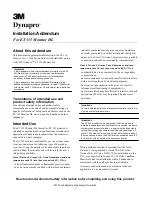
7.
Use a hammer and flat plate to drive the
bushings into the mounting tube.
8.
Inspect the castor spindle for wear, and replace
it if it is damaged.
9.
Push the castor shaft through the bushings and
mounting tube.
10.
Slide the thrust washer and spacer(s) onto the
spindle.
11.
Install the tensioning cap on the castor spindle
to retain all the parts in place.
Servicing the Castor
Wheels and Bearings
The castor wheel rotates on a high-quality roller
bearing and is supported by a spanner bushing. Even
after many hours of use, provided that the bearing
was kept well lubricated, bearing wear will be minimal.
However, failing to keep the bearing lubricated will
cause rapid wear. A wobbly castor wheel usually
indicates a worn bearing.
1.
Remove the locknut from the capscrew holding
the castor wheel assembly between the castor
fork (
g010829
Figure 22
1.
Castor wheel
4.
Spanner bushing
2.
Capscrew and locknut
5.
Roller bearing
3.
Bushing (2)
6.
Washer (2)
2.
Grasp the castor wheel and slide the capscrew
out of the fork.
3.
Pull the spanner bushing out of the wheel hub
(
).
4.
Remove the bushing from the wheel hub and
allow the bearing to fall out.
5.
Remove the bushing from the opposite side of
the wheel hub.
6.
Check the bearing, spanner, and inside of the
wheel hub for wear, and replace any damaged
parts.
7.
To assemble the castor wheel, push the bushing
into the wheel hub.
8.
Slide the bearing into the wheel hub.
9.
Push the other bushing into the open end of the
wheel hub to captivate the bearing inside the
wheel hub (
).
10.
Carefully slide the spanner through the bushings
and the wheel hub.
11.
Install the castor wheel assembly between
the castor fork and secure it in place with the
capscrew, washers, and locknut.
12.
Lubricate the castor wheel bearing through the
grease fitting with No. 2 lithium grease.
Servicing the Cutting
Blades
Blade Safety
•
Inspect the blade periodically for wear or damage.
•
Use care when checking the blades. Wrap the
blades or wear gloves, and use caution when
servicing the blades. Only replace or sharpen the
blades; never straighten or weld them.
•
On multi-bladed machines, take care as rotating a
blade can cause other blades to rotate.
Checking for a Bent Blade
After striking a foreign object, inspect the machine
for damage and make repairs before starting and
operating the equipment. Torque all the spindle-pulley
nuts to 176 to 203 N∙m (130 to 150 ft-lb).
1.
Position the machine on a level surface, raise
the cutting unit, engage the parking brake, put
the traction pedal in
NEUTRAL
, put the PTO lever
in the O
FF
position, shut off the engine, and
remove the ignition key.
Note:
Block the cutting unit to prevent it from
accidentally falling.
20













































